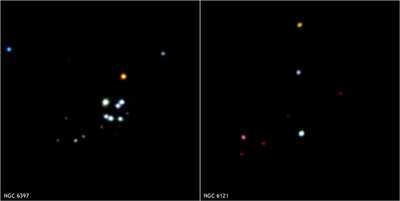Globular Clusters "Surprisingly Less Mature" Than First
Thought
Just when we thought we had the universe figured out... NASA
throws us a curveball. Some of the oldest objects in the universe
may still have a long way to go, according to a new study using
NASA's Chandra X-ray Observatory. These new results indicate that
globular clusters might be surprisingly less mature in their
development than previously thought.

Globular clusters -- dense bunches of up to millions of stars
found in all galaxies -- are among the oldest known objects in the
universe, with most estimates of their ages ranging from 9 to 13
billions of years old. As such they contain some of the first stars
to form in a galaxy, and understanding their evolution is critical
to understanding the evolution of galaxies.
"For many years, globular clusters have been used as wonderful
natural laboratories to study the evolution and interaction of
stars," said John Fregeau of Northwestern University, who conducted
the study. "So, it's exciting to discover something that may be new
and fundamental about the way they evolve."
Conventional wisdom is that globular clusters pass through three
phases of evolution or development of their structure,
corresponding to adolescence, middle age, and old age. These "ages"
refer to the evolutionary state of the cluster, not the physical
ages of the individual stars.
In the adolescent phase, the stars near the center of the
cluster collapse inward. Middle age refers to a phase when the
interactions of double stars near the center of the cluster prevent
it from further collapse. Finally, old age describes when binaries
in the center of the cluster are disrupted or ejected, and the
center of the cluster collapses inwards.
For years, it has been thought that most globular clusters are
middle-aged with a few being toward the end of their evolution.
However, Chandra data, along with theoretical work, suggest most
clusters may actually be closer to interstellar adolescence.
 "It's remarkable that these objects,
which are thought to be some of the oldest in the universe, may
really be very immature," said Fregeau, whose paper appears in The
Astrophysical Journal. "This would represent a major change in
thinking about the current evolutionary status of globular
clusters."
"It's remarkable that these objects,
which are thought to be some of the oldest in the universe, may
really be very immature," said Fregeau, whose paper appears in The
Astrophysical Journal. "This would represent a major change in
thinking about the current evolutionary status of globular
clusters."
If confirmed, this result would help reconcile other
observations with recent theoretical work that suggest the
tightness of the central concentration of stars in the most evolved
globular clusters is consistent with them being in a middle, rather
than an advanced phase of evolution. Other theoretical studies have
suggested it can take longer than the current age of the universe
for globular clusters to reach old age.
Besides improving the understanding of the basic evolution of
globular clusters, this result has implications for understanding
stellar interactions in dense environments. It also removes the
need for exotic mechanisms -- some involving black holes -- that
were thought to be needed to prevent the many middle-aged clusters
from collapsing.
"Some exotic scenarios, including some of my own, have been
invoked to try to make sense of the observations and save the old
theory," said Fregeau. "If this result holds up, we don't have to
worry about the exotic scenarios any more."
NASA's Marshall Space Flight Center, Huntsville, AL manages the
Chandra program for the agency's Science Mission Directorate. The
Smithsonian Astrophysical Observatory controls science and flight
operations from the Chandra X-ray Center in Cambridge, MA.
 NTSB Final Report: Rutan Long-EZ
NTSB Final Report: Rutan Long-EZ ANN FAQ: Turn On Post Notifications
ANN FAQ: Turn On Post Notifications Classic Aero-TV: ICAS Perspectives - Advice for New Air Show Performers
Classic Aero-TV: ICAS Perspectives - Advice for New Air Show Performers ANN's Daily Aero-Linx (06.28.25)
ANN's Daily Aero-Linx (06.28.25) Aero-News: Quote of the Day (06.28.25)
Aero-News: Quote of the Day (06.28.25)




